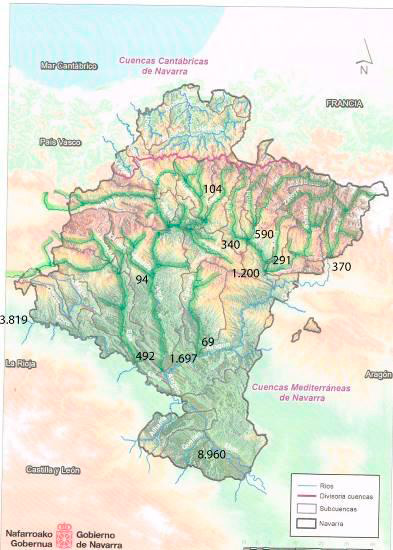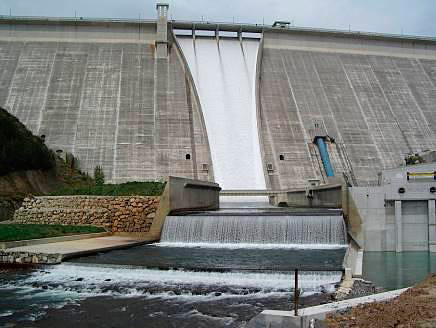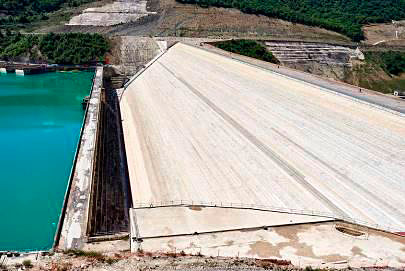23 October
Global Seminars & Invited Speaker Series
HYDRAULIC HERITAGE IN NAVARRA
Water in Navarra in 2019
Francisco Galán Soraluce
Civil Engineer
1. data general of Navarra
The following map shows the hydrological outline of Navarra. Of the total surface area of 10,391 km2, 90% (9,400 km2) corresponds to the Mediterranean basin and 10% (1,000 km2) to the Cantabrian basin.

Rivers of Navarre with natural inflows in hm3.
The total population of Navarre, on January 1, 2018, is 647,554 inhabitants, of which 54,650 live in the Cantabrian basin and 592,904 in the Mediterranean basin. Of these, 365,000 belong to the Pamplona region. In the Cantabrian basin the population is small, rainfall is high and there are no major water needs, so all supplies are made with water from springs or direct intakes from the riverbeds. For this reason, we will refer here only to water from the Mediterranean basin.
The main rivers of the Mediterranean basin are the Ega, the Arga and the Aragón, as the popular saying goes: "they make the Ebro male". The rivers on the right bank of the Ebro (Alhama and Queiles) have reduced contributions and we will not consider them, nor other minor rivers (Odrón, Mayor) on the left bank. The Ega and Arga rivers have most of their basin in Navarra, so we will consider them in their entirety. The Aragón, on the other hand, upstream of the Yesa reservoir, only has in Navarra the basin of the Esca, so, in order to estimate the contributions of the rivers of Navarra, we will take into account the whole of the Irati and the Esca. Details of the reservoirs in each basin can be seen below:
|
Ebro Basin |
|
|
|
||
|
Basin |
Reservoirs |
Construction |
Height |
Hm3 |
Total (Hm3) |
|
Ega |
- |
- |
- |
0,0 |
0,0 |
|
Arga |
Alloz |
1930 |
67 |
84,0 |
|
|
|
Urdalur |
1994 |
55 |
5,4 |
|
|
|
Eugui |
1971 |
48 |
21,4 |
110,8 |
|
Irati |
Irabia |
1947 |
44 |
14,0 |
|
|
|
Itoiz |
2008 |
118 |
418,0 |
432,0 |
|
Aragon |
Mairaga |
1988 |
37 |
2,1 |
|
|
|
Yesa |
2019 |
92 |
1.079,0 |
|
|
|
El Ferial |
1992 |
34 |
8,1 |
1.089,2 |
|
|
|
|
|
TOTAL |
1.632,0 |
The conclusion of the above is that in Navarra there is a lot of water and few reservoirs.
2. Supply possibilities
We have calculated the supply possibilities using the total natural contribution of the rivers. Assuming a population in the Mediterranean basin of 783,000 inhabitants, which represents a 33% increase over the current population, and a supply of 350 l/hb./day, higher than the current Mancomunidad de la Comarca de Pamplona, the Issue necessary for the supply is 100 hm3. Assuming that the ecological flow is 10% of the annual contribution, as in the previous Ebro Hydrological Plan, the Issue available for irrigation would be:
|
Natural supply with water from Navarra |
4.000 |
hm3 |
|
Supply to 783,000 inhabitants |
100 |
hm3 |
|
Ecological flow rate: 10 % contribution |
400 |
hm3 |
|
available for irrigation |
3.500 |
hm3 |
This Issue would allow, with an endowment of 6,400 m3/hb./year, to irrigate 538,000 ha, a surface area much larger than the maximum possible in Navarra. It can be seen that the resources of Navarre are very high and can comfortably meet all the needs.
Need to regulate contributions
Irrigation demands begin in May and are concentrated in the June-September period, while inflows occur between October and May. The data studied show that in order to have water for irrigation, it is necessary to have dammed the water in winter and spring, in order to have it available in June. If this is not done, the inflows are not usable. In other words, the reservoirs are necessary. The extent of the inflows in some months sample the importance of the reservoirs being in the rivers and not in diversion. The above shows that: 1) The utilization of the important contributions of the rivers of Navarre requires the construction of reservoirs. 2) If we want to be able to count on the contribution of average with security, hyperannual reservoirs must be built.
4. Ecological flows established in the Ebro Hydrological Plan.
The following table shows the ecological flows established in the current Ebro Hydrological Plan for ordinary conditions:
|
|
ECOLOGICAL FLOWS OF THE EBRO HYDROLOGICAL PLAN IN m3/s |
|
|||||||||||
|
River |
OCT |
NOV |
DEC |
JAN |
FEB |
SEA |
ABR |
MAY |
JUN |
JUL |
AGO |
SEP |
TOTAL |
|
|
m3/s |
m3/s |
m3/s |
m3/s |
m3/s |
m3/s |
m3/s |
m3/s |
m3/s |
m3/s |
m3/s |
m3/s |
hm3 |
|
Ega in Andosilla |
1,41 |
1,72 |
1,87 |
1,88 |
1,91 |
1,71 |
1,86 |
1,61 |
1,36 |
1,05 |
0,85 |
0,98 |
47,77 |
|
Arga in Huarte |
0,37 |
0,44 |
0,45 |
0,45 |
0,66 |
0,62 |
0,65 |
0,39 |
0,36 |
0,32 |
0,29 |
0,32 |
13,93 |
|
Irati in Aoiz |
0,90 |
1,93 |
2,07 |
3,10 |
3,01 |
2,80 |
2,81 |
2,86 |
1,29 |
0,90 |
0,90 |
0,90 |
60,22 |
|
Salazar in Aspurz |
0,13 |
0,20 |
0,25 |
0,39 |
0,54 |
0,72 |
0,72 |
0,73 |
0,38 |
0,17 |
0,12 |
0,12 |
11,71 |
|
Irati in Liédena |
2,36 |
2,61 |
2,75 |
2,75 |
2,75 |
2,66 |
2,84 |
2,45 |
2,24 |
1,99 |
1,85 |
1,97 |
76,72 |
|
Aragon in Caparroso |
4,63 |
4,89 |
5,07 |
5,00 |
4,78 |
4,69 |
5,13 |
4,63 |
4,22 |
3,67 |
3,40 |
3,91 |
141,88 |
The values of the Ega are much higher than what actually circulates, those of the Arga and the Irati are obtained with the discharges of the Eugui and Itoiz reservoirs, those of the Salazar are reduced and those of the Aragón depend on the discharge of the Yesa and Itoiz reservoirs. The rivers of Navarre have a torrential nature, so the low water flows are very low and, although they vary from one year to another, they are those that circulate throughout the summer and, sometimes, an important part of the autumn.
5. Description of the main basins
Ega River: The possibility of building reservoirs should be analyzed and reserve its basins by means of the appropriate legal measures. Without these reservoirs it is impossible to count on the great contribution of the Ega river and not even the ecological flows established in the Hydrological Plan of the Ebro can be assured. The necessary measures must be taken to ensure the supply of the population of the basin with quality water.
Arga River: The Arga is studied in its tributaries and in its most singular locations.
Salado River: It is the exception in Navarra. It is completely regulated and has the best hydroelectric production system.
Ulzama River: It is not possible to count on the contribution of the Ulzama; the possible reservoirs should be studied and their vessels safeguarded. Its regulated flow would allow dilution of the Arga water downstream of the Arazuri discharge.
River Arga at Eugui: It is not possible to count on about 80 hm3 of water from the Arga at Eugui; the possible reservoirs should be studied and their vessels safeguarded. Its regulated flow would allow a dilution of the Arga water downstream of the Arazuri discharge.
River Arga at its mouth: It is not possible to count on some 1,300 hm3 of contribution from the Arga; the possible reservoirs should be studied and their vessels safeguarded. Its regulated flow would allow a dilution of the Arga water downstream of the Arazuri discharge. It is regrettable that in the basin a river with this contribution should have to be supplied for water supply and irrigation with water from other basins.
Irati River at Itoiz: 340 Hm3/year for irrigation through the Canal de Navarra, for lands located in the Autonomous Community of Navarra. 60 Hm3/year for the supply of populations and industries that are served by water from said Canal in the same Autonomous Community.
Of the total irrigation Issue there is a concession of 223 Hm3/year for irrigation of the Comunidad General de Regantes del Canal de Navarra, which with 6,400 m3/ha/year means a total of 34,842 ha, corresponding to the 1st Phase of the canal and its Expansion. The total surface area foreseen for the 1st Phase and its expansion is 35,618 ha. The irrigation area planned for the 2nd Phase is 21,500 ha.
After a study of data, we have seen that the irrigable area depends, to a large extent, on the endowment considered for the 1st Phase. It seems reasonable that this endowment should be adjusted to what is actually going to be used. To this end, it would be appropriate to establish a tariff system, similar to that for electricity, in which there would be a capacity term, depending on the reservation, and another for consumption, which would encourage leaving available for the 2nd Phase the water that is not going to be used.
Supply with water from the Ega to the irrigated areas of its basin: In order to increase the irrigable area in the 2nd Phase over the areas indicated, it should be considered to supply water to the irrigable area of the Ega with duly regulated flows from its own basin. In the Ega river basin, the Ríomayor reservoir can be built with a capacity of 32 Hm3 , which would allow the irrigation of some 6,000 ha. The construction of the Ríomayor reservoir is included in the Normative Provisions of the Ebro Hydrological Plan (art. 32): "The reservoir in the Ríomayor stream (Ega river basin). The resources regulated by the Ríomayor reservoir will be used for the new irrigable area of Tierra Estella, included in the Irrigation Plan of the Autonomous Community of Navarre, Autonomous Decree 105/ 2008, estimated at some 7,000 ha. A reservation of 32 Hm3 per annum is established for this purpose, at application of the Government of Navarre".
Actions to improve the Itoiz dam: The current dam is a free spillway dam, probably due to the fact that in the initial project the dam was made of loose materials that were projected without floodgates as a result of the collapse of the Tous dam, which was a rockfill dam and in a great flood, in which they could not open the floodgates, poured over the crest and the water "carried" the dam. When they changed from a breakwater dam to a concrete dam, they kept many things, including, I think wrongly, making it without floodgates.

Itoiz Dam spilling on April 4, 2004. See that it has no floodgates.
project of the Pitillas-2nd Phase canalization: The project of the Pitillas canalization-right bank of the Ebro must be done taking into consideration: the real or fictitious environmental problems existing along its route; the fact that the passage of the Aragón and the Ebro must necessarily be done with pipes in siphons; the flow that it is finally decided to carry; and the possibility that the Pitillas reservoir, located at the beginning of the works of the 2nd Phase, could be at a high level that would create a significant head loss that would facilitate the circulation of water at high speeds in pipes, with the consequent smaller diameter. The solution of the entire pipeline layout could allow it to be executed in phases, as has always been done in water supply works.
Conclusions: The irrigable area of the 2nd Phase must be determined, both in years of inflow average and inflow leave, for which it will be necessary to decide what endowment is set for the irrigable areas of the 1st Phase, which has a notable influence in the case of years of low inflows. The placement of floodgates on the dam spillway should be planned, as is the case with almost all concrete dams, since the capacity of the reservoir is increased by 21.76 hm3 , thus significantly improving the regulation capacity. It will be necessary to design a pumping system that will allow the 55 hm3 that are below their intake level in the reservoir to be raised to the Canal. If we wish to give a hyper-annual character to the contribution of the Irati, the capacity of Itoiz would have to be increased by building another reservoir upstream to complement it.
Salazar river at Aspurz: The natural contribution of the Salazar river at Aspurz is, according to the Ebro Hydrological Plan, 291 hm3. Many documents have considered the option of diverting it, with a weir and a tunnel, to the Yesa reservoir. This is an excellent option that should be taken up again, as it has very few effects and 170 hm3 (equivalent to an average flow of 5.4 m3/s) means the irrigation of 26,562 hectares, with an endowment of 6,400 m3/ha/year.
Aragón river at Yesa: The natural contribution of the Aragón river at Yesa is, according to the Ebro Hydrological Plan, 1,426 hm3. The data contributed show very important values, with great variation from one year to another, which made it advisable for the reservoir to have a hyper-annual character, so it was projected at 1,525 hm3. The work was awarded under these conditions and with the favorable environmental report , but one more of the disastrous hydraulic decisions of the Government of Rodríguez Zapatero stopped it and reduced the reservoir to 1,079 hm3, with which it is currently being built. The stoppage of the work has had many inconveniences and it is, among other things, the movement of the right slope of the dam, due to the long time that the excavation was carried out.

Heightening of the Yesa dam.
In any case, going from the current 447 hm3 to the 1,0709 hm3 of the increase is an important improvement. The regulation with the contribution of the Salazar should be analyzed and, if the reservoir is insufficient, the option of another reservoir in the Aragón upstream of Yesa, in Berdún, which could have a significant capacity, should be taken up again.
6. Urban water supply in Navarre
Urban supply in Navarre is generally very satisfactory due to two circumstances: 1) the water is taken at the headwaters of river basins, which implies high quality, without dissolved salts or components of untreated discharges, or risks of possible contamination; and 2) a centralized supply system has been organized through Mancomunidades, which group together the municipalities of each area, which allows supplies with an adequate size of centralized services, treatment stations, etc., which would be impossible for small towns and, in the case of storms and turbid waters, would not be drinkable, which would be impossible for small localities and, in cases of storms and turbid water, the water would not be drinkable.
status An inadequate urban supply system is found in the south of Navarre, where many municipalities take water from the Ebro or from the large canals as they pass through Navarre and, furthermore, they do not have a common water supply system. At this moment, when it is planned to take water from the Canal de Navarra to the right bank of the Ebro, the best way to do it should be analyzed; possibly extending the current system of Cadreita-Valtierra-Arguedas to all the towns on the left bank and providing water from Itoiz to the Tudela Treatment Plant, generalizing its use to all the towns on the right bank, although some of them will require pumping, whose energy cost has little repercussion on the price of water for urban supply.
7. Conclusions
- In Navarre there is a large supply of water that can allow the supply of quality water to a population much larger than the current one and irrigate a larger surface area than can be implemented in the Community. But this requires regulating the rivers.
- The installation of floodgates in the Itoiz dam should be carried out to increase its regulation capacity, and a pumping system should be designed to use water from the reservoir that is below the Canal intake level.
- Regulation is also needed to ensure that Pamplona's wastewater discharge is sufficiently diluted.
- It is necessary to define which reservoirs are still possible to build and to safeguard their vessels.
- Efforts should be made to ensure that the demands of each basin are met with contributions from the basin.
